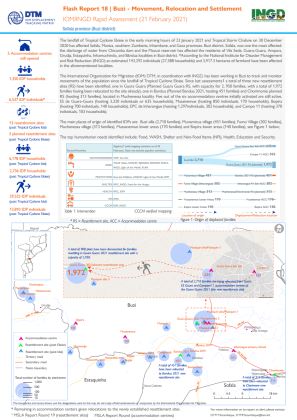-
Countries
-
Data and Analysis
-
Special Focus
-
Crisis Responses
Mozambique – Flash Report 18 Buzi - Movement, Relocation and Settlement (21 February 2021)

Contact
DTM Mozambique, DTMMozambique@iom.int
Language
English
Location
Mozambique
Period Covered
Feb 21 2021
Feb 21 2021
Activity
- Mobility Tracking
- Event Tracking
- Site Assessment
The landfall of Tropical Cyclone Eloise in the early morning hours of 23 January 2021 and Tropical Storm Chalane on 30 December 2020 has affected Sofala, Manica, southern Zambezia, Inhambane, and Gaza provinces. Buzi district, Sofala, was one the most affected: the discharge of water from Chicamba dam and the Mavuzi reservoir has affected the residents of Vila Sede, Guara-Guara, Ampara, Grudja, Estaquinha, Inhamuchindo, and Bândua localities in Buzi district. *According to the National Institute for Disaster Management and Risk Reduction (INGD) an estimated 143,292 individuals (27,388 households) and 3,917.3 hectares of farmland have been affected in the aforementioned localities.
The International Organization for Migration (IOM) DTM, in coordination with INGD, has been working in Buzi to track and monitor movements of the population since the landfall of Tropical Cyclone Eloise. Since last assessments1 a total of three new resettlement sites (RS) have been identified, one in Guara Guara (Planned Guara Guara RS, with capacity for 2, 950 families, with a total of 1,972 families having been relocated to the site already), one in Bandua (Planned Bandua 2021, hosting 451 families) and Chorimonio planned RS (hosting 313 families), located in Muchenessa locality. Five out of the six accommodation centres initially activated are still active, ES de Guara-Guara (hosting 3,320 individuals or 635 households), Mussinemue (hosting 850 individuals, 170 households), Bopira (hosting 700 individuals, 140 households), EPC de Inharongue (hosting 1,297individuals, 302 households), and Campo 11 (hosting 370 individuals, 103 households).
The main places of origin of identified IDPs are: Buzi villa (2,710 families), Munamicua village (451 families), Fumo Village (302 families), Muchenessa village (313 families), Mussanemue lower areas (170 families) and Bopira lower areas (140 families), see Figure 1 below;
The top humanitarian needs identified include: Food, WASH, Shelter and Non-Food Items (NFI), Health, Education and Security.
